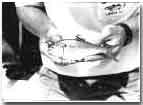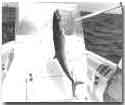Kingfish Rules
Kingfish Rules
By Jerry LaBella
Learn the secrets, from the pros, for catching king mackerel!
Few fish along the Gulf’s green water zone can match the fight and tenacity of a king mackerel. Perhaps for this reason kings top the list when it comes to competitiveness and big-money tournaments.
Here in Louisiana, most of the hype surrounding king mackerel competition originated along the East Coast where tournaments run rampant. Thanks to such influence, many king mackerel anglers have refined their techniques to a science.
There’s no question about it, if you give an angler a choice between catching big fish or small fish, you don’t have to guess which ones he’ll choose. This is more so with tournament circuit king anglers. They hunt for what’s called "smokers." These are fish no less than 30 lbs. and, as their nickname might imply, can literally smoke line from a reel upon hookup.
Among tournament king anglers it is customary to avoid catching the smaller kings under 15 lbs., categorically referred to as "snakes." These are kings that predominately make up the catch for the charter boat and commercial fishery. Consequently, snakes are more often caught by meat seekers and the less informed who resort to faster trolling methods that employ Drone spoons, Japanese feathers or strip baits.
In contrast, smokers seldom take fast-moving or free-lined baits. Trying to free-line a big, live bait to them frustratingly produces an amberjack, shark or some other unwanted species. The trick is figuring out how to get the bait to the smokers, while keeping it away from the undesirables.
The science of accomplishing this is all too familiar to tournament-circuit goers and those who have successfully experimented with the tactic for any length of time. They’ve discovered that there are basically several kingfish rules one has to know: what to do, how to get it, how to keep it and how to rig it.
RULE 1: THE RIGHT BAIT
One of the main secrets to successfully catching smokers lies in the right choice of bait. While kings differ in bait preferences--depending on the waters they’re in--most tournament anglers use 10-inch, live porgies (menhaden). But, as many anglers are well aware, porgies are difficult to catch and just as arduous to keep alive for any length of time.
To catch these prized bait fish, a wide-mesh, 10- to 12-ft. mono cast net is needed. Considering the fact that large porgies are quick to escape from conventional nets that sink too slowly and have relatively narrow spreads, it’s imperative that the lead line weigh at least 15 lbs. so that net drops quickly upon contact with the water.
Because of its size and awkwardness, a net casting dish can make the throwing job much easier, especially when thrown from a boat. Pros usually have these nets custom made, since they’re difficult to find in most sporting goods stores.
RULE 2: FINDING THE BAIT
Freshly caught porgies incite more strikes. Hence, it is best to catch porgies early in the morning, immediately prior to use, as they seem to lose their scented slim coating after a few hours in an aerator. Evidence of this shows up in the form of a foamy, meringuelike toping--more often noticed on the water’s surface of closed system bait wells.
Aside from the open Gulf, porgies are likely found in backwaters and intersections of deep canals, near marinas or harbors, close to beaches, behind jetties or near piers. Be alert to their telltale presents by observing the water’s surface for blips, spurts and splashes. The presents of diving pelicans are also a dead giveaway, but don’t pay attention to sea gulls; they don’t eat 10-inch porgies.
RULE 3: KEEPING THE BAIT ALIVE
However, catching porgies is one thing; keeping them alive is another. Bait-saving containers with corners must be avoided or porgies will fatally damage themselves, as they have a tendency to gang up and inflict bloody wounds to their noses. For this reason, uses a round container of at least 50-gallon capacity to give the porgies plenty room to swim.
Porgies also need a lot of oxygen to live. For aeration, a circulation system that pumps outside water works best. Such systems constantly move and replace water by means of an overflow tube located in the tank’s upper level. This type system accomplishes three vital things: removes toxins produced by the porgies’ waste, naturally aerates the water through swirl jetting, and keeps the porgies swimming in an unobstructed circle.
RULE 4: RIGGING TERMINAL TACKLE
Careful consideration to rigging of leaders and baits is most essential for an effective presentation and extended life. The leader outlined herein consists of two sections: header leader and tail leader. The tail leader has two treble hooks (Eagle Claw 4X-extra strong), one of which is hooked through the porgy’s nose, and the other in the back near top center. Placing the hooks anywhere else may kill the porgy or significantly shorten its life.
 For leader material, use single strand stainless wire (bronze camouflage), rather than braided types that are bulkier and produce more water drag. Consideration to this is critical, since the porgies must swim naturally, with the least line resistance. Moreover, leaders of the aforesaid wire gauge and color are more apt to prevent kings from becoming line wary, particularly when water clarity is high.
For leader material, use single strand stainless wire (bronze camouflage), rather than braided types that are bulkier and produce more water drag. Consideration to this is critical, since the porgies must swim naturally, with the least line resistance. Moreover, leaders of the aforesaid wire gauge and color are more apt to prevent kings from becoming line wary, particularly when water clarity is high.
The header leader (main leader) should be 44 lb. test and 6 ft. long. The tail leader (final section) should 58 lb. test and 7 inches long for rigging the two treble hooks on each end.
One end the header leader is attached to the tail leader at one of the treble hook eyelets.
The mono fishing line to header leader connection is made via a #10, 50 lb. test ball bearing swivel (note: a 2 oz. egg sinker is needed on the flat line--non-downrigger--ahead of the swivel). On one end of the swivel eyelet the mono fishing line is attached by means of a double improved clinch knot. On the other end of the swivel the remaining end of the header leader is attached.
All wire connections are made by passing 3 inches of wire through an eyelet, doubling back, and twisting it into several tightly wrapped turns. After making the wraps, a multipurpose terminal tackle pliers should be used to break off the tag end of the wire by bending it back and forth several times. Don’t cut it with wire cutters; it will leave a razor-sharp snag.
RULE 5: STAGGERING THE LINES
Troll at least two lines; one on a downrigger and one flat line. On the downrigger line, set it astern about 20 ft., and lower it 15-20 ft. in depth. On the flat line, set it astern about 30 ft.
More downriggers and flat lines can be used but they must be staggered in depths and set astern in 10 ft. differentials. Troll no more lines than can be reasonably handled among each crew member--one per person on the average.
RULE 6: DRAG SETTING
Careful attention to drag setting and line choice can be critical. Recommended mono test in the big game class should be between 15-25 lb. test. Heavier lines bring in factors of resistance and visibility, as previously mentioned under rule 4. Drags should be set to 1/3 the line test rating. Thereafter drags may be tightened, but only after the king has shown unmistakable evidence of tiring.
RULE 7: TROLLING TECHNIQUE
Trolling too fast is one of the main mistakes king anglers make. Idle speed is all that’s needed to troll live porgies, and in some instances this may be too fast--depending on the type of engine and whether it is twin screws. In the latter, both engines may be running, but only with one engine drive engaged for the troll.
If the porgies seem to be flipping around and swimming in an unnatural-looking way, this indicates too fast of a trolling speed. To slow the troll down, one of two things can be done; either use a vertical board mounted on the lower unit, or pull a bucket as a sea anchor.
The use of a fish finder is indispensable. While trolling it’s a good idea to keep a constant watch for bait clusters and their depths. Doing so will make it easier to determine whether downriggers need to be adjusted.
It’s customary and effective to allow the porgies to occasionally free swim in selected bait clusters. Once an unusually thick bait cluster shows on the fish finder, immediately place the engine drive in neutral to allow the baits to drift into position and swim.
To make this tactic most productive, always keep a frisky porgy on each line. Accordingly, make it a practice to periodically check the baits for liveliness, and replace those not up to par.
RULE 8: DETERMINE FEEDING PATTERN
Migratory species attain a feeding pattern that may change from day to day, depending on tide and conditions. While trolling, observe the place where strikes occur, and repeat this trolling pattern. Frequently, for example, if strikes occur down current from an oil platform, most likely the kings will occupy the same position in relation to every other rig or structure in the area. Once the pattern is established, odds of catching more kings the same way drastically increase.
LOUISIANA KINGS UNMATCHED
 While other areas along the Gulf and East Coast produce kings of longer length, it’s an established fact that those caught off the coast of Louisiana have larger girths. According to marine biologists, it is this very fact that makes Louisiana kings naturally heavier and stronger than those found along other parts of the Gulf and East Coast. So it’s no wonder why king anglers who have caught kings elsewhere have experienced firsthand the distinct contrast--harder fights, more aggressiveness and reel-burning runs.
While other areas along the Gulf and East Coast produce kings of longer length, it’s an established fact that those caught off the coast of Louisiana have larger girths. According to marine biologists, it is this very fact that makes Louisiana kings naturally heavier and stronger than those found along other parts of the Gulf and East Coast. So it’s no wonder why king anglers who have caught kings elsewhere have experienced firsthand the distinct contrast--harder fights, more aggressiveness and reel-burning runs.
Visit Jerry LaBella at http://www.jerrylabella.com
|
